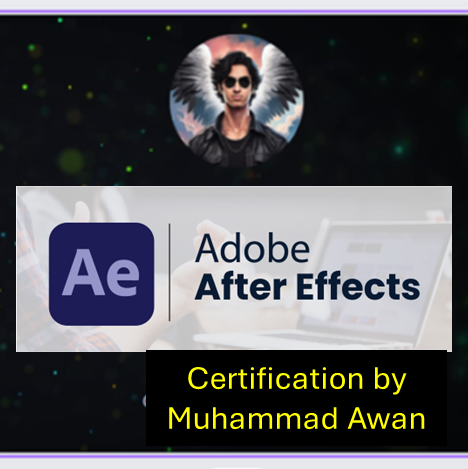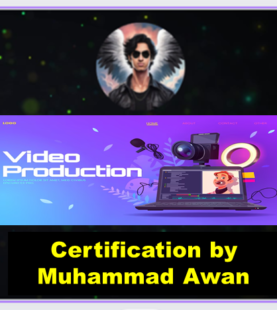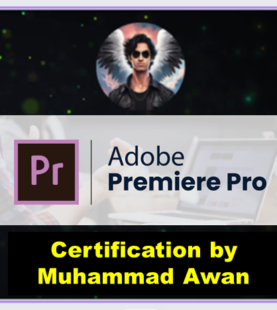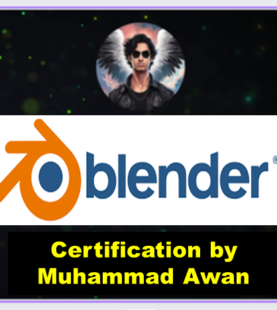Certified Adobe After Effects Professional
- Design, Design / Branding, Graphic Designing, Marketing, Photography, Photography and Designs, Project Management
- 28 (Registered)
-
(0 Review)

Adobe After Effects is a powerful software used for creating motion graphics and visual effects in film, television, and online content. It’s widely regarded as an industry standard, offering a vast array of tools and features that enable users to create stunning visual effects and animations. Here’s an overview of some of the key tools in After Effects and examples of how they can be used.
LEARNING OBJECTIVES
Adobe After Effects is an industry-standard software for creating motion graphics, visual effects, and animations. A comprehensive course on After Effects should aim to equip learners with essential skills and knowledge to effectively use the software for various creative projects. Here are the key learning objectives that such a course should cover:
1. Understanding the Interface and Workflow
- Navigating the Interface: Familiarize learners with the After Effects workspace, including panels, tools, and shortcuts.
- Project Organization: Teach efficient project management techniques, such as importing assets, creating compositions, and organizing layers.
2. Fundamentals of Animation
- Keyframe Animation: Introduce the concept of keyframes and how to create basic animations using position, scale, rotation, and opacity properties.
- Easing and Timing: Teach techniques for smooth animation transitions using easing curves and the Graph Editor.
3. Working with Layers and Masks
- Layer Management: Explore layer types, hierarchy, and organization within compositions.
- Masking Techniques: Teach learners how to use masks to control visibility and manipulate specific areas of layers.
4. Introduction to Effects and Presets
- Applying Effects: Demonstrate how to apply effects to layers to enhance visuals or achieve specific looks.
- Using Presets: Introduce pre-built effects presets and how to customize them for different purposes.
5. Advanced Compositing Techniques
- Green Screen (Chroma Keying): Teach methods for removing backgrounds and integrating footage using the Keylight effect.
- Tracking and Stabilization: Introduce motion tracking techniques to attach graphics to moving objects and stabilize shaky footage.
6. 3D Space and Camera Tools
- Creating 3D Layers: Teach how to work with 3D layers and manipulate them in a 3D space.
- Using Cameras: Introduce creating and animating cameras to simulate real-world camera movements and depth of field effects.
7. Expressions and Automation
- Understanding Expressions: Introduce the basics of expressions and how to use JavaScript-based code to automate animations and link properties.
- Practical Applications: Provide examples of using expressions for complex animations, syncing animations to audio, and creating procedural effects.
8. Puppet Tools and Character Animation
- Puppet Pin Tool: Teach how to use Puppet Tools to animate character movements and create organic animations.
- Character Rigging: Introduce basic rigging techniques for character animation using Puppet Tools and layer parenting.
9. Rendering and Output
- Rendering Settings: Teach learners how to set up render settings for different output formats and resolutions.
- Exporting: Demonstrate exporting compositions for various platforms, such as web, broadcast, and social media.
10. Creative Projects and Portfolio Development
- Hands-on Projects: Provide practical exercises and creative projects that reinforce skills learned throughout the course.
- Portfolio Development: Guide learners in creating a portfolio of their work, showcasing their skills and creativity in After Effects.
Conclusion
A well-rounded Adobe After Effects course should not only cover technical skills but also foster creativity and problem-solving abilities. By mastering these learning objectives, learners will be equipped to create professional-quality motion graphics, visual effects, and animations using Adobe After Effects, enhancing their career prospects in the fields of animation, video production, and digital media.
Curriculum
- 1 Section
- 10 Lessons
- 10 Weeks
- Lessons10
- 1.0Adobe After Effects: 3D Space and Camera Tools
- 1.1Adobe After Effects: Effects and Presets
- 1.2Adobe After Effects: Expressions
- 1.3Adobe After Effects: Keyframe Tools
- 1.4Adobe After Effects: Layer Tools
- 1.5Adobe After Effects: Masking and Rotoscoping Tools
- 1.6Adobe After Effects: Motion Tracking and Stabilization
- 1.7Adobe After Effects: Puppet Tools
- 1.8Adobe After Effects: Timeline Panel
- 1.9Adobe After Effects: Tools and Their Examples
Instructor
🌟Aspiring Digital Artist, Animator, Cinematographer & Visual Effects Entrepreneur. 👨🏻💼CEO/Founder: https://ApexCreativeStudios.net offering Graphic Designing I Animation I Videography I VFX I Photography Services, 🎥Multimedia Coach: At https://BusinessCoach.sa creating & producing Graphic Designing content based on education, studies as well as business. 🎬Content Creator: At The Lounge, created & produced Digital Marketing content for Meta, Instagram, Tiktok & Youtube for my clients. 🌐At https://ApexCreativeStudios.net :






